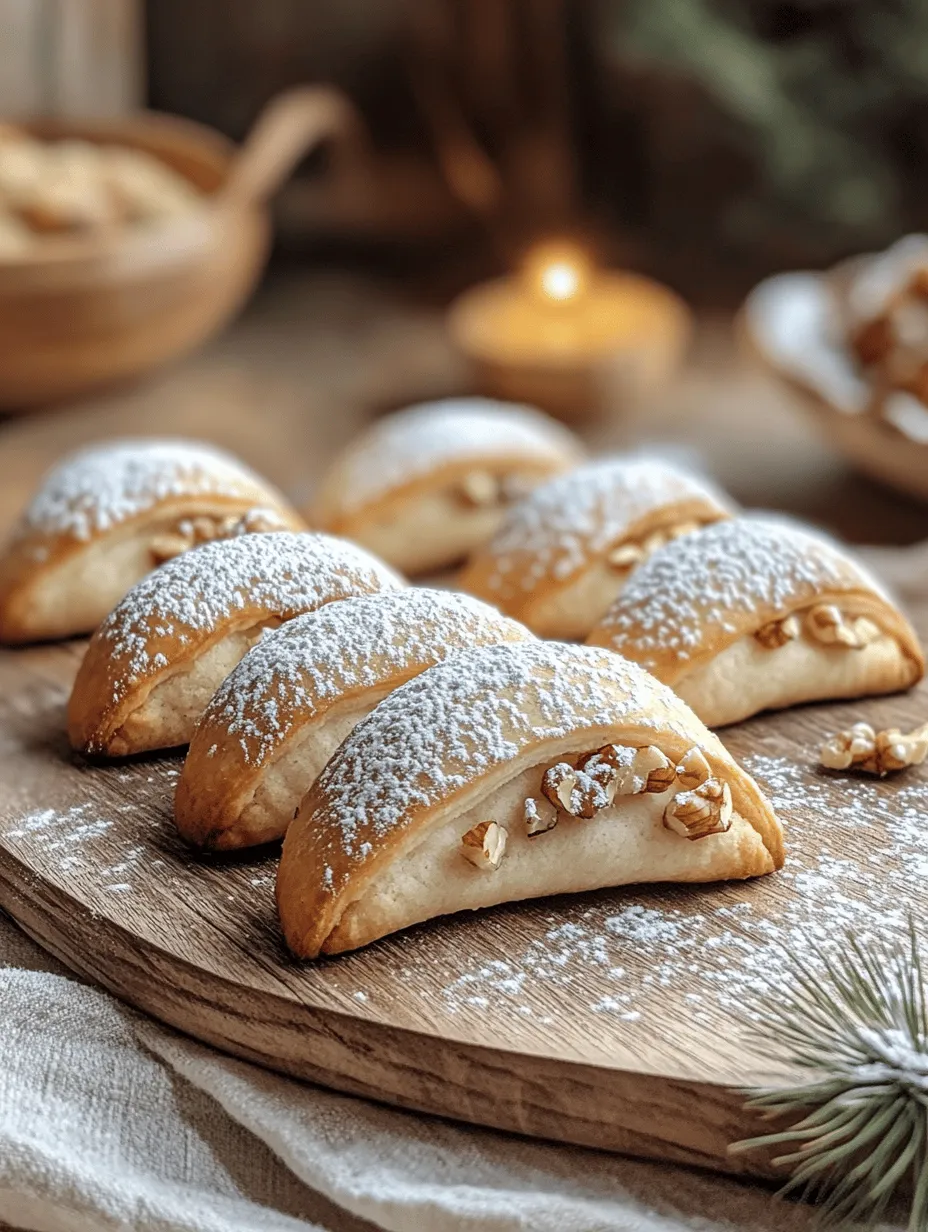Introduction to Italian Nut Roll Cookies
Welcome to the delightful world of Italian Nut Roll Cookies, a sweet treat that has captured the hearts and taste buds of many. These cookies are a cherished staple in Italian households, often gracing dessert tables during festive occasions, family gatherings, and holiday celebrations. The rich buttery flavors combined with the satisfying crunch of nuts create a harmonious blend that is simply irresistible.
The roots of Italian Nut Roll Cookies can be traced back to various regions in Italy, where they are sometimes known as “noci,” referring to the nuts that are a key component of the recipe. Traditionally, these cookies symbolize family and togetherness, with recipes often passed down through generations. The process of making these cookies can be a wonderful way to bond with loved ones, as they involve simple techniques that anyone can master with a little practice.
One of the most appealing aspects of Italian Nut Roll Cookies is their versatility. They can be made in large batches, making them perfect for sharing with friends or bringing to festive gatherings. Their unique rolled shape, often filled with a mixture of finely chopped nuts and sugar, makes for an eye-catching presentation that is sure to impress. Not only are they visually appealing, but they also offer a delightful mix of textures and flavors that can easily become a beloved addition to any dessert table.
What sets these cookies apart is their simplicity. You don’t need to be a baking expert to whip up a batch of these nutty delights. With just a few key ingredients and straightforward instructions, you can create a cookie that embodies the essence of Italian baking. So, let’s dive into the details of this delicious recipe, starting with an understanding of the essential ingredients that make these cookies so special.
Understanding the Ingredients for Italian Nut Roll Cookies
The success of Italian Nut Roll Cookies relies heavily on the quality and combination of a few key ingredients. Each component plays a significant role in contributing to the overall flavor and texture of the cookies. Here’s a closer look at the essential ingredients that make these cookies a beloved treat.
The Role of All-Purpose Flour in Cookie Making
All-purpose flour is the foundation of most cookie recipes, and Italian Nut Roll Cookies are no exception. Flour provides the necessary structure and stability to the cookies, allowing them to hold their shape during baking. When mixed with the other ingredients, it forms gluten, which helps bind the dough together. For these cookies, using a good quality all-purpose flour ensures a consistent texture that is neither too crumbly nor overly dense.
The Importance of Unsalted Butter
Unsalted butter is another crucial ingredient in Italian Nut Roll Cookies. The use of unsalted butter allows for better control over the sweetness and saltiness of the cookies. Since the amount of salt in salted butter can vary, using unsalted butter gives bakers more precise control over the flavor profile. The rich, creamy texture of unsalted butter contributes to the cookies’ tender crumb and enhances the overall buttery flavor, making each bite melt in your mouth.
Sugar Types and Their Impact on Texture
When it comes to sugar, both granulated and powdered sugar play important roles in this recipe. Granulated sugar is typically used in the dough, as it helps achieve a light and fluffy texture. When creamed with butter, granulated sugar incorporates air into the mixture, contributing to the cookies’ rise. On the other hand, powdered sugar is commonly used for dusting the finished cookies, adding a sweet, delicate finish that complements the nutty flavors beautifully.
The Use of Salt in Baking
While it may seem counterintuitive, a small amount of salt is essential in baking, even in sweet recipes like Italian Nut Roll Cookies. Salt acts as a flavor enhancer, balancing the sweetness and bringing out the rich flavors of the butter and nuts. Just a pinch can elevate the overall taste of the cookies, ensuring that they are well-rounded and delicious.
Egg Yolks: The Secret to Richness
Egg yolks are often regarded as the secret to achieving rich, moist cookies. In this recipe, they contribute to the overall tenderness and richness of the dough. The fat in the yolks helps create a softer texture, while also adding an additional layer of flavor. When combined with the other ingredients, egg yolks help bind everything together, leading to a perfectly cohesive dough that is easy to work with.
Flavoring with Vanilla Extract
Vanilla extract is a staple in many baking recipes, and it plays a significant role in enhancing the flavor of Italian Nut Roll Cookies. The aromatic qualities of vanilla add depth to the overall flavor profile, providing a warm and inviting essence. Opting for pure vanilla extract, rather than imitation, ensures that the cookies are imbued with the highest quality flavor.
Nuts: Choosing Between Walnuts and Hazelnuts
Finally, the choice of nuts is what truly sets Italian Nut Roll Cookies apart. Traditionally, walnuts or hazelnuts are used, each offering distinct flavors and health benefits. Walnuts have a rich, slightly bitter taste that pairs beautifully with the sweetness of the cookies. They are also packed with omega-3 fatty acids, making them a nutritious choice. On the other hand, hazelnuts provide a sweet, buttery flavor that can elevate the cookie to new heights. Their unique taste adds a delightful crunch and a hint of richness that is hard to resist. Ultimately, the choice between walnuts and hazelnuts comes down to personal preference, and both options are sure to create delicious results.
Step-by-Step Instructions for Making Italian Nut Roll Cookies
Now that we’ve explored the key ingredients that contribute to the deliciousness of Italian Nut Roll Cookies, let’s dive into the step-by-step instructions for making these delightful treats. This comprehensive guide will walk you through each stage of the process, ensuring that you have all the information you need to create a perfect batch of cookies.
Preheating the Oven and Preparing the Baking Sheet
Before you start mixing your ingredients, it’s essential to preheat your oven to the correct temperature—typically around 350°F (175°C). Preheating ensures that your cookies bake evenly and achieve the desired texture. While the oven is heating, prepare your baking sheet by lining it with parchment paper. This step not only prevents the cookies from sticking but also allows for easy removal after baking.
Mixing the Dough: A Closer Look
In a large mixing bowl, begin by creaming together the unsalted butter and granulated sugar. Using an electric mixer, beat the butter and sugar on medium speed until the mixture is light and fluffy, which usually takes about 3 to 5 minutes. This process incorporates air into the dough, contributing to a tender texture once baked.
Once the butter and sugar are well combined, it’s time to add the egg yolks and vanilla extract. Beat them into the mixture one at a time, ensuring that each yolk is fully incorporated before adding the next. The addition of these ingredients will help create a rich and flavorful base for your cookies.
Gradually Adding Flour and Salt
With your wet ingredients nicely combined, it’s time to introduce the dry ingredients. Gradually sift in the all-purpose flour and a pinch of salt to the butter mixture. Using a spatula or wooden spoon, gently fold the flour into the wet ingredients until just combined. Be careful not to overmix, as this can lead to tough cookies. You want to achieve a soft, slightly sticky dough that holds together without being overly dry.
Incorporating Nuts for Texture
Now comes the fun part—incorporating the nuts! Finely chop your choice of walnuts or hazelnuts, or use store-bought nut meal for a quicker option. Gently fold the chopped nuts into the dough, ensuring they are evenly distributed throughout. This step not only adds a delightful crunch to each cookie but also infuses them with the rich, nutty flavor that makes Italian Nut Roll Cookies so special.
With the dough prepared and the nuts mixed in, you are now ready to shape and bake your cookies. The next steps will guide you through rolling, cutting, and baking your delightful Italian Nut Roll Cookies, creating a treat that is sure to impress your family and friends. Stay tuned for the continuation of this delicious journey!

Folding Technique for Even Distribution of Chopped Nuts
To ensure that the chopped nuts are evenly distributed throughout your Italian Nut Roll Cookies without overworking the dough, it’s essential to use a gentle folding technique. Begin by incorporating the nuts into the dough gradually. Instead of stirring vigorously, which can lead to a tough texture, use a spatula or your hands to fold the mixture. Start by placing the dough in a bowl and sprinkling the chopped nuts over it.
Then, using a motion similar to folding a letter, lift the dough from the bottom and fold it over the nuts, turning the bowl as you go. This method allows you to incorporate the nuts without activating too much gluten. Aim for a uniform distribution of nuts throughout the dough, ensuring each cookie has a delightful crunch.
Shaping the Cookies: Techniques and Tips
Shaping your Italian Nut Roll Cookies can be a fun and creative process. Begin by dividing the dough into manageable portions, typically about the size of a golf ball. For the classic log shape, roll each portion between your palms to form a cylinder about 1 inch in diameter.
For a crescent shape, take a portion of dough and flatten it slightly. Then, use your fingers to curl the edges inward, creating a crescent moon shape. As a visual cue, aim for uniformity in size; each cookie should be approximately the same length and width for even baking. This consistency not only enhances the presentation but also ensures they bake evenly.
If you prefer a more decorative touch, consider rolling the logs in chopped nuts or sprinkles before baking. This adds an appealing texture and visual interest to your cookies while enhancing their nutty flavor.
Baking the Cookies: Timing and Temperature
Preheat your oven to 350°F (175°C) and line a baking sheet with parchment paper. When placing the shaped cookies on the sheet, leave enough space between them to allow for slight spreading during baking.
The baking process typically takes around 15-20 minutes. Keep an eye on your cookies as they bake; they are done when they turn a light golden brown and feel firm to the touch. A useful tip for determining doneness is to gently lift one cookie; the bottom should be lightly browned, indicating it is ready to come out of the oven.
Avoid overbaking, as this can lead to a dry texture. Once they are golden and firm, remove the cookies from the oven and allow them to cool on the baking sheet for a few minutes before transferring them to a wire rack to cool completely.
Cooling and Dusting with Powdered Sugar
After baking, let the cookies rest on the baking sheet for about 5 minutes. This cooling period is essential as it allows them to firm up slightly, making them easier to transfer. Using a spatula, carefully move the cookies to a wire rack.
Once the cookies have cooled completely, it’s time for the finishing touch: dusting them with powdered sugar. This not only enhances their visual appeal but also adds a delightful sweetness that complements the nutty flavor. To achieve an even coating, use a fine mesh sieve or a sifter to sprinkle the powdered sugar lightly over the cookies.
For a more festive presentation, consider adding a touch of cocoa powder or cinnamon to the powdered sugar mix before dusting, offering an intriguing flavor twist.
Exploring Variations and Serving Suggestions
Using Different Nuts or Flavors
While the traditional Italian Nut Roll Cookies typically feature walnuts or hazelnuts, there are countless ways to customize this recipe to suit your personal taste. Feel free to experiment with different types of nuts, such as almonds, pecans, or pistachios. Each nut brings its own unique flavor and texture to the cookies.
In addition, consider enhancing the flavor profile by adding extracts. A splash of almond extract can provide a lovely depth of flavor, while incorporating a hint of orange or lemon zest can brighten the cookies, making them even more delightful.
Serving Options for Italian Nut Roll Cookies
These cookies are incredibly versatile and can be served in various ways. They pair beautifully with a warm cup of coffee or tea, making them an excellent choice for afternoon gatherings or cozy evenings at home.
For special occasions, consider presenting the cookies on a decorative platter alongside a selection of other treats, such as biscotti or chocolate-covered fruits. This allows guests to sample a variety of flavors and textures, elevating the overall experience.
The Cultural Significance of Italian Nut Roll Cookies
Traditional Occasions for Italian Nut Roll Cookies
Italian Nut Roll Cookies are often associated with celebrations and family gatherings. Traditionally, they are made during the Christmas season, where they grace dessert tables alongside other festive treats.
These cookies are not just about taste; they carry a sense of nostalgia and connection to family traditions. Many families pass down their recipes through generations, each adding their unique twist.
Regional Variations Across Italy
As with many beloved recipes, Italian Nut Roll Cookies vary by region. In some areas, you may find them filled with a rich chocolate ganache, while others may use different nuts or spices. The variations reflect the local ingredients and culinary influences, showcasing the diversity of Italian cuisine.
For example, in the northern regions, where hazelnuts are plentiful, you might encounter cookies that emphasize this nut’s flavor, while southern regions may incorporate almonds. Each bite tells a story of its origins, making these cookies a delightful exploration of Italian culture.
Nutritional Information and Health Benefits
Caloric Content and Macronutrient Breakdown
Understanding the nutritional content of Italian Nut Roll Cookies can help you enjoy them mindfully. On average, a single cookie contains approximately 100-120 calories, depending on the size and specific ingredients used. The macronutrient breakdown typically includes around 5-7 grams of fat, 10-15 grams of carbohydrates, and 1-2 grams of protein.
These cookies do contain sugar, primarily from the powdered sugar dusting, so it’s advisable to enjoy them in moderation.
Health Benefits of Nuts
The star ingredient of these cookies, nuts, brings numerous health benefits. Walnuts and hazelnuts, commonly used in this recipe, are rich in heart-healthy fats, antioxidants, and nutrients.
For instance, walnuts are an excellent source of omega-3 fatty acids, which play a vital role in brain health and reducing inflammation. Hazelnuts are packed with vitamin E, an antioxidant that supports skin health and protects against oxidative damage.
Incorporating nuts into your diet, even in a sweet treat like these cookies, can contribute to overall well-being.
Conclusion: Enjoying Italian Nut Roll Cookies
The experience of making and enjoying Italian Nut Roll Cookies is a delightful journey that combines tradition, flavor, and creativity. From the gentle folding technique that ensures the perfect texture to the final dusting of powdered sugar that enhances their visual appeal, every step of the process is infused with joy.
These cookies not only offer a delicious treat but also carry cultural significance, connecting you to Italian culinary traditions. Whether enjoyed during the holidays with family or savored alongside a cup of coffee on a quiet afternoon, Italian Nut Roll Cookies are sure to become a cherished recipe in your home.
As you embark on this baking adventure, remember that the joy of cooking goes beyond the ingredients; it’s about creating memories and sharing love through food. So gather your loved ones, roll up your sleeves, and indulge in the delightful experience of making Italian Nut Roll Cookies.


